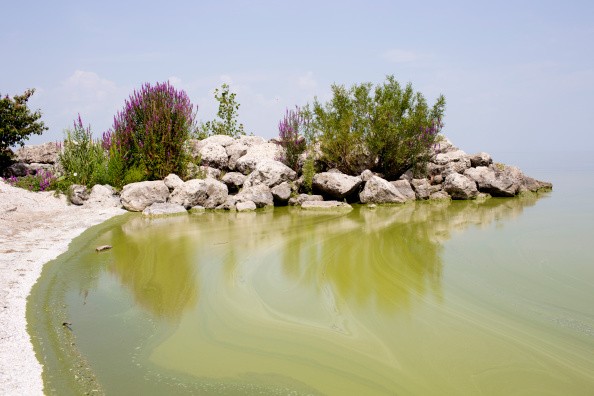Lake Erie To See Worst Algal Bloom In 2015 With Heavy Rains Making It More Toxic
| Saranya Palanisamy | | Jul 16, 2015 04:58 PM EDT |
(Photo : Photo by Aaron P. Bernstein/Getty Images) The National Oceanic and Atmospheric Administration (NOAA) of the U.S. has reported that the algal bloom in the Lake Erie in 2015 could be the second most toxic bloom ever reported in the century.
The National Oceanic and Atmospheric Administration (NOAA) of the U.S. has reported that the algal bloom in the Lake Erie in 2015 could be the second most toxic bloom ever reported in the century.
The algal bloom in 2011 is the most toxic bloom ever which has set a record severity of 10 in the ensemble model prepared by the NOAA with the help of its research partners. The algal bloom in 2015 is expected to reach the severity index of 8.7 with minimum expected range of 8.1 to maximum of 9.5 which may equal or exceed the bloom severity in 2013. It is to be noted that the cyanobacterial bloom in 2014 was 6.5 in the severity index, reported The Fish Site.
Like Us on Facebook
It is reported that algal bloom would peak in September and the severity of the bloom might vary with difference in locations as well as with the wind. As a result of algal bloom in Lake Erie local governments might have to spend a lot of money in order to treat water for drinking purposes. They are equally troublesome for swimmers and boaters.
Heavy rains that fell in the month of June reportedly washed large amount of fertilizers into Lake Erie which might reasonably substantiate the increased severity of algal bloom in 2015. Tim Davis, scientist in NOAA noted the change in climate can't be considered as the sole reason for algal bloom but also the use of fertilizers. He added that unless the use of fertilizers are taken care of, problems of the sort can't be managed. He also noted that some measures for controlling the use of fertilizers are underway, reported Climate Central.
Scientists at NOAA noted on their measures in controlling algal bloom, "We are continuing on Lake Erie. The modeling effort is guiding guidelines for phosphorus reduction. We also are starting a project jointly with EPA, NASA, and USGS, called the CyAN (Cyanobacteria Assessment Network) that will take what we've learned about monitoring and modeling with satellite on Lake Erie and apply it nationally. That starts this year, and will be a four year project," reported News Quench.
TagsLake erie, Algal Bloom, Fertilizers, Cyanobacteria, National Oceanic and Atmospheric Administration (NOAA)
©2015 Chinatopix All rights reserved. Do not reproduce without permission
EDITOR'S PICKS
-

Did the Trump administration just announce plans for a trade war with ‘hostile’ China and Russia?
-

US Senate passes Taiwan travel bill slammed by China
-

As Yan Sihong’s family grieves, here are other Chinese students who went missing abroad. Some have never been found
-

Beijing blasts Western critics who ‘smear China’ with the term sharp power
-

China Envoy Seeks to Defuse Tensions With U.S. as a Trade War Brews
-

Singapore's Deputy PM Provides Bitcoin Vote of Confidence Amid China's Blanket Bans
-

China warns investors over risks in overseas virtual currency trading
-

Chinese government most trustworthy: survey
-

Kashima Antlers On Course For Back-To-Back Titles
MOST POPULAR
LATEST NEWS
Zhou Yongkang: China's Former Security Chief Sentenced to Life in Prison

China's former Chief of the Ministry of Public Security, Zhou Yongkang, has been given a life sentence after he was found guilty of abusing his office, bribery and deliberately ... Full Article
TRENDING STORY

China Pork Prices Expected to Stabilize As The Supplies Recover

Elephone P9000 Smartphone is now on Sale on Amazon India

There's a Big Chance Cliffhangers Won't Still Be Resolved When Grey's Anatomy Season 13 Returns

Supreme Court Ruled on Samsung vs Apple Dispute for Patent Infringement

Microsoft Surface Pro 5 Rumors and Release Date: What is the Latest?













